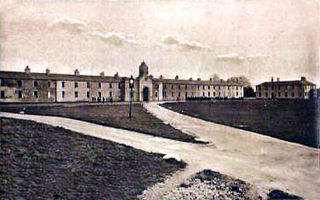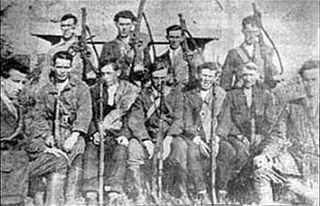Gerald Bartley was an Irish Fianna Fáil politician who served as Minister for the Gaeltacht and Minister for Defence from 1959 to 1965. He was a TD for the Galway and Galway West constituencies from 1932 until his retirement in 1965.
James Colbert was an Irish revolutionary, politician and farmer.
Francis Joseph Carty was a leader of the Irish Republican Army (IRA) in the Irish War of Independence, and a long-serving Fianna Fáil Teachta Dála (TD). Carty was the Commandant of the IRA's South Sligo Brigade and its Flying column.

Thomas Hales was an Irish Republican Army (IRA) volunteer and politician from West Cork.

The executions during the Irish Civil War took place during the guerrilla phase of the Irish Civil War. This phase of the war was bitter, and both sides, the government forces of the Irish Free State and the anti-Treaty Irish Republican Army (IRA) insurgents, used executions and terror in what developed into a cycle of atrocities. From November 1922, the Free State government embarked on a policy of executing Republican prisoners in order to bring the war to an end. Many of those killed had previously been allies, and in some cases close friends, of those who ordered their deaths in the civil war. In addition, government troops summarily executed prisoners in the field on several occasions. The executions of prisoners left a lasting legacy of bitterness in Irish politics.

David Neligan, known by his soubriquet "The Spy in the Castle", was a crucial figure involved in the Irish War of Independence (1919–21) and subsequently became Director of Intelligence for the Irish Army after the Irish Civil War (1922–23).

Denis Allen was an Irish revolutionary and politician.
Stephen Fuller was an Irish Fianna Fáil politician who served as a Teachta Dála (TD) for the Kerry North constituency from 1937 to 1943.
The Kerry Senior Hurling Championship is an annual hurling competition organised by the Kerry County Board of the Gaelic Athletic Association since 1889 for the top hurling teams in the county of Kerry in Ireland.
Michael Brendan Colbert was an Irish Fianna Fáil politician.
Daniel Corkery was an Irish politician and Commandant in the Irish Republican Army (IRA) during the Irish War of Independence.
John Joseph Sheehy was an Irish political/military activist and sportsperson. He participated in the Irish War of Independence and Irish Civil War in the Irish Republican Army (IRA), where he was a senior figure in County Kerry. He also gained fame as a successful Gaelic footballer representing the Kerry county team.

Ballymullen Barracks is an Irish military installation at Tralee, County Kerry in Ireland.

George O'Shea was an Irish Republican Army (IRA) soldier who fought with the Anti-Treaty side during the Irish Civil War. He was one of eight men killed by Free State forces in the Ballyseedy Massacre, a defining event in Irish history.

Timothy Lyons, a.k.a. Aero or Aeroplane, was an Irish Republican Army (IRA) soldier who fought with the Anti-Treaty side during the Irish Civil War. After a three-day siege by Free State forces at Clashmealcon, County Kerry, he died after falling from a cliff onto rocks and then being shot.
James McEnery was a farmer and IRA soldier who fought on the anti-Treaty side in the Irish Civil War in north Kerry. He surrendered during a three-day siege by Free State forces, in the last significant action of the War, and was executed seven days later.
Edmond Greaney [also 'Edward', 'Eamonn/Eamon' and 'Greany' on historical documents] was a farm labourer and IRA soldier who fought on the anti-Treaty side in the Irish Civil War in north Kerry. He was captured by Free State forces and executed after the last major action of the War.
Thomas McGrath was an IRA soldier who fought on the anti-Treaty side in the Irish Civil War in north Kerry. He drowned after trying to escape a siege by Irish Free State forces at Clashmealcon during what was the last major military action of the War.
Patrick O'Shea was a farm labourer and IRA soldier who fought on the anti-Treaty side during the Irish Civil War in north Kerry. He died after falling from a cliff trying to escape from Irish Free State forces in a siege at Clashmealcon in the last major military action of the civil war.

Ballyheigue Castle, in Ballyheigue, County Kerry, is a ruined Tudor-gothic-revival-style mansion. It was used as a residence of the Crosbie family and later as a gaol. It has been burned twice. It is currently part of a golf course.







